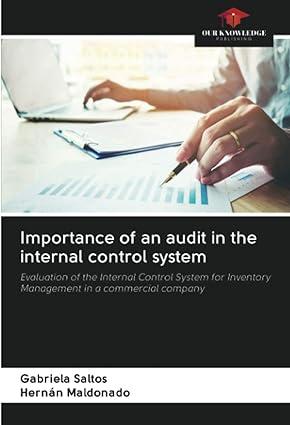
20201231

Exercise 7.14 Last Ltd has two divisions, Time and Leisure. Each f these regarded as a separate CGU. At 31 December 2019, the carrying amounts of the assets of the two divisions were: Time Leisure Plant $1,480 $1,180 Accumulated depreciation (640) (370) Patent 300 Inventories 52 76 Receivables 63 64 Goodwill 20 26 The receivables were regarded as collectable, and the inventories' fair value less costs of disposal was equal to its carrying amount. The patent had a fair value less costs of disposal of $275. The plant at Time was depreciated at $300 p.a., and that at Leisure was depreciated at $210 p.a. Last Ltd undertook impairment testing at 31 December 2019, and determined the recoverable amounts of the two divisions to be Time $995 Leisure 966 As a result, management increased the depreciation of the Time plant from $300 to $330 p.a. for the year 2020 By 31 December 2020, the performance in both divisions had improved, and the carrying amounts f the assets of both divisions and their recoverable amounts were as follows: Time Leisure Carrying amount $1,353 $1,407 Recoverable amount 1,494 1,533 For the year ended 31 December 2020, calculate the maximum amount of reversal of impairment. Plant Patent $ For the year ended 31 December 2020, record the journal entry for reversal of impairment. (Enter debit entries first, followed by credit entries. Credit account titles are automatically indented when the amount is entered. Do not indent manually. If no entry is required, select "No Entry" for the account titles and enter 0 for the amounts. Round answers to 0 decimal places, e.g. 5,275.) Leisure ACCount and explanation Debit Credit (Reversal of impairment loss) Time ACCOUNT and explanation Debit Credit Exercise 7.14 Last Ltd has two divisions, Time and Leisure. Each f these regarded as a separate CGU. At 31 December 2019, the carrying amounts of the assets of the two divisions were: Time Leisure Plant $1,480 $1,180 Accumulated depreciation (640) (370) Patent 300 Inventories 52 76 Receivables 63 64 Goodwill 20 26 The receivables were regarded as collectable, and the inventories' fair value less costs of disposal was equal to its carrying amount. The patent had a fair value less costs of disposal of $275. The plant at Time was depreciated at $300 p.a., and that at Leisure was depreciated at $210 p.a. Last Ltd undertook impairment testing at 31 December 2019, and determined the recoverable amounts of the two divisions to be Time $995 Leisure 966 As a result, management increased the depreciation of the Time plant from $300 to $330 p.a. for the year 2020 By 31 December 2020, the performance in both divisions had improved, and the carrying amounts f the assets of both divisions and their recoverable amounts were as follows: Time Leisure Carrying amount $1,353 $1,407 Recoverable amount 1,494 1,533 For the year ended 31 December 2020, calculate the maximum amount of reversal of impairment. Plant Patent $ For the year ended 31 December 2020, record the journal entry for reversal of impairment. (Enter debit entries first, followed by credit entries. Credit account titles are automatically indented when the amount is entered. Do not indent manually. If no entry is required, select "No Entry" for the account titles and enter 0 for the amounts. Round answers to 0 decimal places, e.g. 5,275.) Leisure ACCount and explanation Debit Credit (Reversal of impairment loss) Time ACCOUNT and explanation Debit Credit








